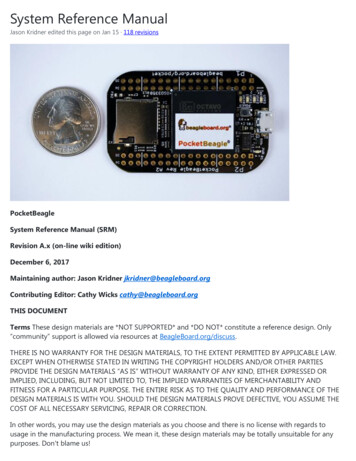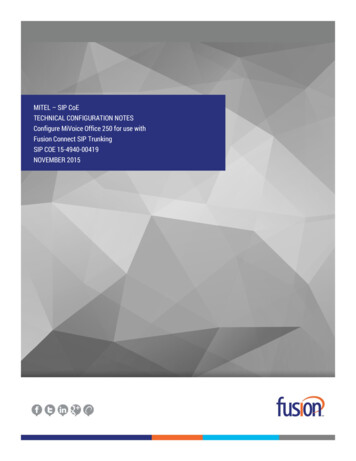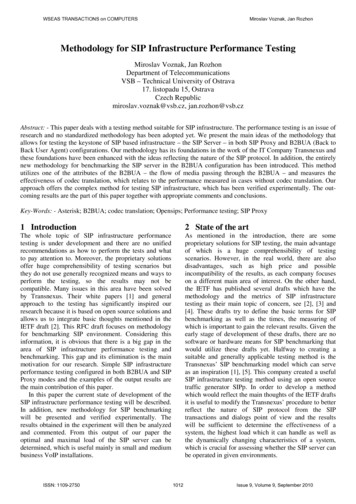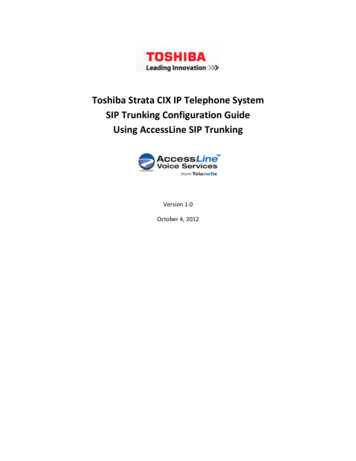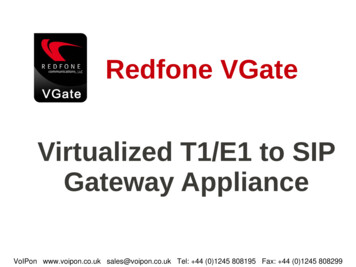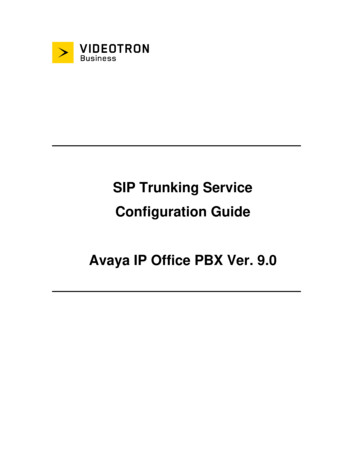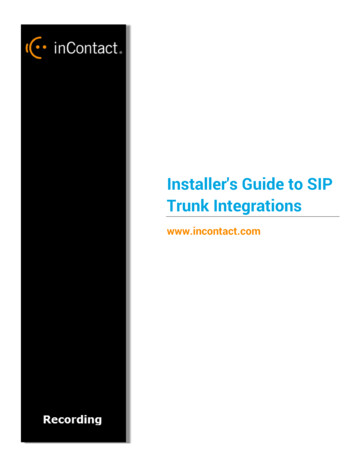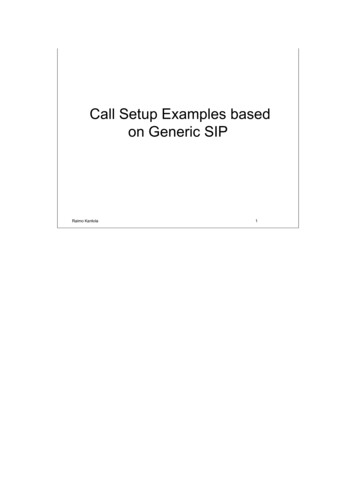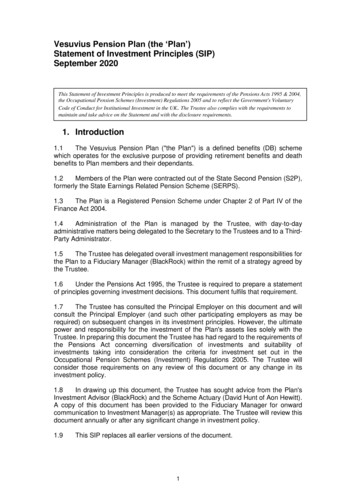
Transcription
Vesuvius Pension Plan (the ‘Plan’)Statement of Investment Principles (SIP)September 2020This Statement of Investment Principles is produced to meet the requirements of the Pensions Acts 1995 & 2004,the Occupational Pension Schemes (Investment) Regulations 2005 and to reflect the Government's VoluntaryCode of Conduct for Institutional Investment in the UK. The Trustee also complies with the requirements tomaintain and take advice on the Statement and with the disclosure requirements.1. Introduction1.1The Vesuvius Pension Plan ("the Plan") is a defined benefits (DB) schemewhich operates for the exclusive purpose of providing retirement benefits and deathbenefits to Plan members and their dependants.1.2Members of the Plan were contracted out of the State Second Pension (S2P),formerly the State Earnings Related Pension Scheme (SERPS).1.3The Plan is a Registered Pension Scheme under Chapter 2 of Part IV of theFinance Act 2004.1.4Administration of the Plan is managed by the Trustee, with day-to-dayadministrative matters being delegated to the Secretary to the Trustees and to a ThirdParty Administrator.1.5The Trustee has delegated overall investment management responsibilities forthe Plan to a Fiduciary Manager (BlackRock) within the remit of a strategy agreed bythe Trustee.1.6Under the Pensions Act 1995, the Trustee is required to prepare a statementof principles governing investment decisions. This document fulfils that requirement.1.7The Trustee has consulted the Principal Employer on this document and willconsult the Principal Employer (and such other participating employers as may berequired) on subsequent changes in its investment principles. However, the ultimatepower and responsibility for the investment of the Plan's assets lies solely with theTrustee. In preparing this document the Trustee has had regard to the requirements ofthe Pensions Act concerning diversification of investments and suitability ofinvestments taking into consideration the criteria for investment set out in theOccupational Pension Schemes (Investment) Regulations 2005. The Trustee willconsider those requirements on any review of this document or any change in itsinvestment policy.1.8In drawing up this document, the Trustee has sought advice from the Plan'sInvestment Advisor (BlackRock) and the Scheme Actuary (David Hunt of Aon Hewitt).A copy of this document has been provided to the Fiduciary Manager for onwardcommunication to Investment Manager(s) as appropriate. The Trustee will review thisdocument annually or after any significant change in investment policy.1.9This SIP replaces all earlier versions of the document.1
1.10In this document:1.10.1 “Sponsoring Employer” means Vesuvius Holdings Limited. “InvestmentManager(s)” refers to those responsible for segments of underlyinginvestments of the Fund.1.10.2 “Fund” refers to the total investments of the Plan.Additional Voluntary Contributions (AVCs)The Plan’s AVC arrangements are now closed to new contributions. However, thetrustee offers investment alternatives as follows for all AVC investments: Equitable LifePrudential Assurance Company LimitedZurich AssuranceStandard Life (ex-Foseco Members)The Trustees review these investments from time to time with the Investment Advisorand also with Premier Benefits Solutions, an FSA regulated advisor. The Trusteesbelieve that these investments provide members with the appropriate range ofinvestment opportunities given the membership, the level of investment and the factthat the arrangement is closed to new investments. Some investments are retained forhistoric purposes.2. Investment PrinciplesInvestment Objectives2.1The Trustee aims to invest the assets of the Plan prudently to ensure, as far aspossible, that the benefits promised to members are provided. The asset allocationstrategy it has selected is designed to achieve a return consistent with and greaterthan that assumed by the Scheme Actuary in the 2018 Valuation while maintaining aprudent approach to meeting the Plan’s liabilities.In choosing this overall objective, the Trustee recognises the level of risk compared tothe liabilities that accompanies the outperformance target.These objectives have been set in consultation with the Sponsoring Employer and inlight of the assessment of the Employer Covenant, ability to pay and the Employersability to withstand poor investment returns in the future.The performance objectives of the Plan are a) to achieve long term growth of thePlan relative to its liabilities with an acceptable amount of risk and (b) to outperformthe relevant benchmarks taking into account the investment restrictions as defined inthe Investment Management Agreement and which is reviewed on an annual basis.Investment Strategy - General2.2The Trustee will agree an Investment Strategy, reviewed each year, to meetthe Investment Objective. This will be prepared by the Fiduciary Manager inconsultation with the Investment Committee (which consists of representatives of theTrustee and the Principal Employer).2
Previous versions of the SIP recognised that increasing maturity of the Plan's ongoingDB liabilities was likely, in due course, to result in an increasing proportion of the Plan'sassets being invested in liability matching assets. This has been realised in thecompletion of a buy-in of the Plan’s Pensioner Liabilities and subsequent annual buyins of new pensioners until 2018.Risk tolerances will take account of the funding position and the covenant of thePrincipal Employer.Asset classes which are appropriate for the Plan will be selected to set targetallocations and ranges within which the Fiduciary Manager will manage.The strategy will diversify assets across asset types, Investment Managers, geographyand sectors to achieve a reasonable level of diversification to reduce risk.Financial Services Act2.3The Fiduciary Manager is authorised under the Financial Services & MarketsAct 2000 and provides the expertise necessary to manage the allocation of the Plan’sassets competently. In accordance with the Financial Services and Markets Act 2000,the Trustee will determine the investment strategy and the strategic asset allocationbut will delegate day-to-day responsibility for the management of the assets to theFiduciary Manager. The Fiduciary Manager will then manage the underlyingInvestment Managers with selection and de-selection being done in consultation withthe Trustee. The Investment Managers shall provide the skill and expertise necessaryto manage the investments of the Plan competently.2.4The Fiduciary Manager confirms that it will manage the Fund in accordancewith sections 36(1) and 36(5) of the Pensions Act 1995, subject to the limitations onthe discretion given to the Fiduciary Manager by the Trustee. For the purposes ofsection 36 of the Pensions Act 1995, the Fiduciary Manager will exercise its powers ofinvestment with a view to giving effect to the principles contained in this document andany subsequent amendments.Trust Deed2.5No asset categories are specifically excluded, for the Plan as a whole, by theTrust Deed. However the Investment Manager will use all reasonable endeavours notto invest directly in securities of Vesuvius plc or any of its subsidiary companiesexcepting that Vesuvius has made a gift of shares in an Indian subsidiary to theTrustees which they hold at their own discretion and will manage on a discretionarybasis.2.6The Trustee is permitted by the Trust Deed to borrow money. The TrusteeDirectors do not intend to make use of this provision on a regular basis and anyproposal to borrow money will require the approval of the Trustee Directors.Benchmark, permitted assets and ranges2.7The Trustees elected to purchase a buy-in contract with Pension InsuranceCorporation Limited (PIC and the “Contract”). Responsibility for this investment isseparate from the Fiduciary Mandate although the Contract is considered by theFiduciary Manager and the Trustee in assessing the appropriate strategy, benchmarksand investment ranges.The table below shows the strategic asset allocation and strategic benchmarks for theassets that remain with the Fiduciary Manager which has been designed to meet the3
objectives. The strategic asset allocation and benchmarks will be reviewed annually,however, due to the fluctuating nature of markets, changes may also be madethroughout the year by the Trustee.Vesuvius Pension Plan Asset AllocationFund StrategyBenchmark indexGrowth StrategiesLiquid Assets StrategyIlliquid Assets Strategy***Overlay StrategiesLiability Hedging StrategyTarget StrategyPermitted ActiveAllocationRanges**Weight* (%)Minimum Maximum(%)(%)433353See Liquid Assets Benchmark TablebelowSee Illiquid Assets Benchmark Tablebelown/an/a574767n/aBenchmark Actual* Percentage of total Fund.** Active ranges are defined as a percentage of total Fund assets by market value.*** BlackRock will not make changes to the weights of Illiquid Assets held in the Fund.Liquid Assets Benchmark TableLiquid AssetsBenchmark Weight*(%)Active Ranges**(%)Asset ClassBenchmark indexUK EquitiesFTSE All Share Total Return Index0.5 /-2.5Global Developed Equities exUK, HedgedFTSE All World Developed ex UK Indexhedged to GBP11.0 /-3UK CreditIBoxx Sterling Corporate Bond Index Customised***88.5 /-5TOTAL100.0* Percentage of Liquid Assets Strategy assets by market value.** Active ranges are defined relative to the evolved Liquid Assets Benchmark Weight. Minimum weight of 0% andmaximum weight of 100% for all components unless stated otherwise.*** This benchmark is screened / adjusted in the following ways: Issuers capped at 2% of index; Tier 1 and UpperTier 2 financials & their US equivalent excluded.Illiquid Assets Benchmark TableAsset classPropertyInfrastructureNon-Discretionary IndianInvestmentBenchmark IndexIlliquid Asset Benchmark Weight (%)IPD-All-Balanced Fund WeightedAverage Indexn/a (Actual)n/a (Actual)n/a (Actual)n/a (Actual)n/a (Actual)The Liability Hedging Strategy targets an Interest Rate Hedge Ratio of 110% and anInflation Hedge Ratio of 110% relative to the Scheme’s Liability Cashflows.The Trustee is using derivative instruments such as swaps and financial futures tomitigate inflation and interest rate risk and can also use derivative instruments tomitigate currency and equity market risk, for which the Trust Deed has been suitablyamended. This acts as an overlay to the assets shown in the tables above.Determination of Strategy and Benchmarks4
The strategic benchmark and the corresponding strategy were determined with regardto the actuarial characteristics of the Plan, in particular the strength of the fundingposition and the liability profile. The Trustee assumes that equities will outperform giltsover the long term and that active fund management, in some asset classes, can beexpected to add net value. However, the Trustee recognises the potential volatility inequity returns, particularly relative to the Plan’s liabilities, and the risk that theInvestment Manager do not achieve the targets set. When choosing the Plan’s assetallocation strategy, the Trustee considered written advice from its Fiduciary Managerand, in doing so, addressed the following: The need to consider a full range of asset classes.The risks and rewards of a range of alternative asset allocation strategies.The suitability of each asset class.The need for appropriate diversification.Expected Return on InvestmentsGiven the investment strategy outlined above the Trustee expects to achieve a returnabove the liabilities of 0.5% according to BlackRock’s long-term assumptions (as atDecember 2019).Regulatory Requirements2.8The assets shall consist predominantly of investments traded on regulatedmarkets and investment in assets which are not traded on such markets shall be keptto a prudent level.2.9Assets shall be properly diversified in such a way as to avoid excessive relianceon any particular asset, issuer or group of undertakings and so as to avoidaccumulations of risk in the portfolio as a whole. Investments in assets issued by thesame issuer or by issuers belonging to the same group shall not expose the Plan toexcessive risk concentration.2.10 Investment in derivative instruments will be made only if they contribute to areduction of risks, facilitate efficient portfolio management (including the reduction ofcost or the generation of additional capital or income with an acceptable level of risk)or as a method of implementing any liability matching strategy. Any such investmentsmust be made and managed so as to avoid excessive risk exposure to a singlecounterparty and to other derivative operations.2.11 The Trustee or Investment Managers will not borrow money or act as guarantorfor the purpose of providing liquidity.Responsible Investing2.12 The Trustee recognises that ESG risks could impact the ability of the Schemeto meet its investment objectives and therefore the Trustee has considered how toevaluate and manage these risks when setting its investment strategy as set out in thefollowing paragraphs (along with other matters).2.13 The Trustee will ensure that the Scheme’s Fiduciary Manager shall, alongsideother investment risks, integrate consideration of ESG risks throughout its investmentdecision making processes,2.14The Trustee will request that:5
the Fiduciary Manager, as part of its due diligence, assesses the approach of allthe Scheme’s investment managers in integrating ESG risks considerations intothe selection, retention and realisation of investments, before appointing them; the Fiduciary Manager, as part of its ongoing monitoring, will review the adherenceof the Scheme’s investment managers to their ESG principles and, on at least aquarterly basis, will report on key ESG metrics for the Scheme’s investmentmanagers and aggregate these to portfolio level where appropriate; the Fiduciary Manager, as part of its ongoing monitoring, reviews the execution ofvoting and engagement responsibilities and periodically reports back its findings tothe Trustee (for example where the Scheme invests in pooled funds, the Scheme’sinvestment managers are responsible for exercising voting rights and reporting onhow they have exercised those rights); and where UK-domiciled investment managers are not signatories to the FRC’s UKStewardship Code, the Fiduciary Manager shall consider the investmentmanager’s rationale for this position and, where appropriate, report back itsfindings to the Trustee.STEWARDSHIP2.15 The Trustee understands that stewardship can enhance value over the longterm and recognises that it has a responsibility to act as a good steward and protectand grow the long-term value of the Scheme for the benefit of the Scheme’s members.2.16 In order to be a good steward, the Trustee seeks to ensure that the Scheme’srespective stakeholders undertake appropriate activities.2.17 The Trustee expects the Fiduciary Manager to ensure that its objectives areimplemented as far as is reasonably practicable. This includes ensuring to the extentpossible, that the underlying or external managers exercise on the Trustee’s behalfrights and duties as an investor. This should include, where appropriate, voting andengaging with underlying investee companies, as part of an effective stewardshipapproach that meets the Trustee’s expectations. The Trustee expects that voting andengagement activities are carried out in the best financial interests of the assets beingmanaged.2.18 The Trustee has delegated monitoring of underlying or external managers tothe Fiduciary Manager. As part of this responsibility, the Fiduciary Manager is expectedto: Request voting and/or stewardship policies of the underlying or external managers.Enquire about underlying manager’s voting activity with respect to their statedpolicies, where appropriate.Request that underlying investment managers report on an annual basis asummary of the voting actions which have been taken and any votes cast whichdiffer from the stated voting policy of that manager.Provide a summary to the Trustee of the overall level of voting activity on an annualbasis.2.19 The Trustee will engage with the Fiduciary Manager to understand any reportswhich have been provided and challenge any outcomes which it feels are not inkeeping with its stewardship objectives. The Fiduciary Manager is expected to engagewith the underlying or external managers as and when required to facilitate this. Wherean underlying or external manager is not adhering to this policy in line with theTrustee’s expectations, the Trustee would expect the Fiduciary Manager to considerappropriate actions having regard to the long-term financial wellness of the Scheme.6
ARRANGEMENTS WITH MANAGERS2.20 The Trustee seeks to ensure that the Fiduciary Manager is incentivised to actin a way which generates the best long-term results for the Scheme.2.21 The Trustee agrees to share the SIP with the Fiduciary Manager and requestthat the Fiduciary Manager reviews the SIP and confirms that the investment strategyis aligned with the Trustee’s objectives.2.22 The Trustee’s stewardship assessment will take into account the following fiveconsiderations: How the arrangement with the Fiduciary Manager incentivises the FiduciaryManager to align its investment strategy and investment decisions with theTrustee’s investment policies. How that arrangement incentivises the Fiduciary Manager to make decisionsbased on assessments about the medium to long-term financial and non-financialperformance of issuers of debt or equity. How the method and time horizon of the evaluation of the Fiduciary Manager’sperformance and the remuneration for services are in line with the Trustee’sinvestment policies. How the Trustee monitors “portfolio turnover costs” incurred by the FiduciaryManager, and how they define and monitor targeted portfolio turnover or turnoverrange. The duration of the arrangement with the Fiduciary manager.2.23 The Trustee recognises that there are different ways to engage with itsmanagers including legal documentation as well as more informal arrangements suchas ad hoc communication and reporting and monitoring deliverables provided by eachmanager.2.24 The Trustee recognises that the principal manager it has arrangements with isits Fiduciary manager. The arrangement is governed by the IMA between the Trusteeand the Fiduciary Manager. The Trustee ensures that appropriate restrictions areoutlined in the IMA in order to seek to ensure that the decisions which the FiduciaryManager makes are in line with the long-term interests of the Scheme. This includes,but is not limited to, setting a clear investment objective, eligible instruments, assetallocation ranges and which asset classes are in scope for active and/or passivestrategies.2.25 The Trustee has also ensured that the IMA (and the supplemental disclosuresprovided by the Fiduciary Manager) include conflicts of interest policies in order to seekto ensure that incentives are aligned between the Trustee and the Fiduciary Manageras far as is reasonably practicable.2.26 The Fiduciary Manager provides the Trustee with an annual cost transparencyreport. The report provides information in line with latest regulatory requirements forfiduciary managers. On a quarterly basis the Fiduciary Manager reports totalperformance net of fees so that the Trustee is able to take into account the impact offees and costs when evaluating performance. The Trustee believes that in order toappropriately assess the performance of its managers, the net of costs performancereturns should be monitored over various time periods.7
2.27 The Trustee will review the arrangements with the Fiduciary Manager on aregular basis, however there is no restriction on the duration of any arrangement.2.28 The Trustee expects the Fiduciary Manager to review arrangements with theunderlying or external managers which also have no restriction on duration of anyarrangement. the Fiduciary Manager is expected to review these arrangements on anongoing basis and take action to seek to revise any arrangements where it isunderstood to be in the best long-term interests of the Scheme.2.29 The Fiduciary Manager is expected to take into consideration the Trustee’sinvestment objective as well as its Responsible Investing and Stewardship objectiveswhen selecting and/or appointing new underlying or external managers. The FiduciaryManager is also expected to monitor the underlying managers or external managersand take into consideration the investments that they are permitted to make in order toseek that they are aligned with the long-term interests of the Scheme.2.30 The Trustee believes that they have a governance framework in place in orderto seek to ensure that the Fiduciary Manager’s actions are aligned with the fivearrangements policies listed above. If the Trustee has reason to believe that theFiduciary Manager is acting outside of the Trustee’s policies, the Trustee will bring thisto the attention of the Fiduciary Manager as soon as is reasonably practicable andengage with the Fiduciary Manager so that the parties can understand such actionsand seek to resolve any concerns.Benchmark Rebalancing Policy(i)Strategic BenchmarkFor the purposes of rebalancing and for performance assessment, theasset classes have been divided into Liquid Assets and Illiquid Assets.The Liquid portfolio benchmarks will drift in line with market movementsover a twelve-month period and be rebalanced back to the Liquidweights shown above at the last day of July.The Illiquid Weights benchmark weights will not be rebalanced. Thisreflects the nature of the asset classes held.(ii)Permitted Ranges:The Fund will be invested in accordance with the ranges set out above.Currency2.31The base currency for the Plan is Sterling.Investment Restrictions2.32 VotingInvestment Managers may at their discretion, except when otherwise directed by theTrustee, exercise or procure the exercise of any voting rights or other powers anddiscretions conferred on the registered holder or the beneficial owner of any securitiesin the Fund. Notwithstanding the preceding sentence, the Fiduciary Manager may notprocure the exercise of any voting rights attaching to the Fund holdings of In-HouseFunds (i.e. those managed by the Fiduciary Manager) except with the agreement or8
on the specific instructions of the Trustee but may count such holdings for the purposeof constituting a quorum at a general meeting of any In-House Fund.2.33 Collective Investment Schemes and other Comingled FundsInvestment in collective investment schemes and other comingled funds (includinglimited liability partnerships) is permitted, including the Fiduciary Manger's In-HouseFunds.2.34 DerivativesInvestment Manager(s) may deal in derivatives (options, futures, contracts fordifferences and forwards). This includes dealing in derivatives not traded on or underthe rules of a recognised or designated investment exchange (i.e. an over the counter(OTC) derivatives transaction).2.35 Supplementing the FundWhere the Trustee supplements the assets of the Fund by the transfer of additionalcash (“New Cash”) the Investment Manager may place deals before the OutsideCustodian has notified it of receipt into the Fund of the New Cash. In the event thatthe Fund is not credited with the New Cash in sufficient time to settle the deals thatthe Investment Manager has placed, the Investment Manager may overdraw thebank accounts held with the Outside Custodian in order to provide sufficient moniesto settle the deals on their due settlement dates.The Investment Manager may, for settlement purposes and on a temporary basisonly, without prior reference to the Trustee, enter into a transaction on the Trustee’sbehalf which may result in the Investment Manager having to arrange to borrowmoney for the Trustee.2.36 DepositsThe Trustee consents to money market deposits being made with those approvedbanks which meet the Fiduciary Manager's criteria for such deposit takers from time totime. With regard to parts of the Fund managed on a segregated basis by a managerwho is not a member of the BlackRock Group, deposit takers approved by suchmanager are permitted.2.37 StocklendingInvestment Manager(s) will not engage in stocklending except in the case of pooledfunds, where client interests cannot be separated, but the manager must obtainindemnity from the Custodian and all loans should be collateralised in full.2.38 LiquidityWhen setting strategy, the Trustee has regard to ensuring that there is sufficientliquidity to meet any immediate payments. Sufficient assets are held that are broadlyliquid and sufficient to cover any foreseeable requirements either through incomegeneration or through the sale of readily realisable assets such as bonds or equities.3 GovernanceTrustee Directors3.1In respect of the investment of the Plan's assets, the Trustee Directors areresponsible for:a. Reviewing annually the Statement of Investment Principles and modifying itif appropriateb. Appointing (and when necessary, dismissing) the Fiduciary Manager9
c. Conducting strategic investment reviews and agreeing the investmentstrategyd. Appointing (and, when necessary, dismissing) the firm or firms withresponsibilities for the custody of the Plan's assets ("the Custodians") includingmonitoring their security and efficiencye. Assessing the quality of the performance and processes of the FiduciaryManager and agreeing such changes as are deemed necessaryf. Assessing the performance of the senior staff working for the FiduciaryManager and agreeing such changes as are deemed necessaryg. Consulting with the employer when reviewing investment principlesh. Monitoring the success of the Trustee in achieving the Plan objectivesi. Monitoring the performance of advisors to the TrusteeFiduciary Manager and Investment Advisor3.2The Fiduciary Manager whose role encompasses Investment Advisor isresponsible for:a. Developing a revised strategy on an annual basis (‘Annual Investment Plan’)in conjunction with the Trustee resulting in a Strategic Benchmark.b. Ongoing investment strategy and advice.c. Implementing, within guidelines given by the Trustee in the InvestmentStrategy, changes in the asset mix, selecting/ deselecting managers for eachasset class and transition management.d. Providing the Trustee with quarterly statements of the assets, individual andoverall fund performances, cashflows, risk position, asset/liability ratio (basedon the BlackRock LDI cashflow modeller) and corporate actions together witha quarterly report on their actions and future intentions, and any changes to theprocesses applied to their portfolios.e: Management of Plan cash flow and liquidity requirements with the minimumdisruption to ongoing investments.f. Instructing the Custodians in respect of any corporate governance activity inaccordance with the Trustee's guidelines in the Fiduciary ManagementAgreement.g: Liaising with the Custodian and reconciliation of trading and accountinginformation for the Fund.h. Informing the Trustee of any significant personnel changes in relation to thePlan.i. Commenting on the Trustee’s Statement of Investment Principles on requestand informing the Trustee of any non-compliance with the terms of thisStatement of Investment Principles.j: Trustee training and education on investment related issues.The Annual Investment Plan shall at least include:ooooooRisk return targets against liabilitiesA set of definitions and a process to cover the agreed objectives.Strategic asset allocation and weightsThe relevant benchmarksThe rebalancing and liquidity policiesPolicies for the illiquid part of the Plan10
oProcedures for variation of investment guidelines and changes of theStrategic benchmark.Investment Managers(s)3.3Investment Manager(s) of the assets are responsible for:a. investment of funds as instructed by the Fiduciary Managerb. Provision of information required by the Fiduciary Manager for the propermanagement of the assets.General Partners of Limited Partnerships3.4The General Partners of limited partnerships, which invest the Infrastructureare responsible for:a. investment at their discretion, but within the terms of the partnershipagreements, in various infrastructure or hedge fund opportunitiesb. Providing the Fiduciary Manager with quarterly statements of the assets andcash flowsc. Informing the Fiduciary Manager of any significant personnel changesCustodians3.5The Custodians are responsible for:a. The safekeeping of those assets of the Plan for which they have been givenresponsibility and the issues which this coversb. Providing all appropriate administration relating to the Plan's assetsc. Processing all dividends and any tax reclaims in a timely mannerd. Investing cash in a manner consistent with the Trustee's guidelines in theFiduciary Management Agreemente. Notifying the Trustee, Fiduciary Manager and the relevant authorities whenthe Plan's aggregate holdings exceed disclosable amountsf. Dealing with corporate actionsg. Calculating the overall performance of the Plan and reporting this to theTrustee after resolving any discrepancies with the Fiduciary Manager4 Risk ManagementThe Fiduciary Manager operates a comprehensive risk monitoring and managementprocess. This is updated regularly and covers the Plan's risks in asset allocation, andalso the risks run by individual managers against their benchmarks. The FiduciaryManager reports these risks formally to the Trustee on a quarterly basis when thepositions are reviewed by the Investment Committee.The strategy is to focus on risks which are expected to be rewarded, and to minimiserisks which are expected to be unrewarded, as much as is practicable. The Trusteerecognises that a number of risks are involved in the investment of the Plan's assetsas discussed below.4.1Manager RiskThe Trustee's policy is to diversify the assets across a sufficient and practical numberof Investment Managers. All are recognised within the fund management in
investments of the Fund. 1.10.2 "Fund" refers to the total investments of the Plan. Additional Voluntary Contributions (AVCs) The Plan's AVC arrangements are now closed to new contributions. However, the trustee offers investment alternatives as follows for all AVC investments: Equitable Life Prudential Assurance Company Limited
